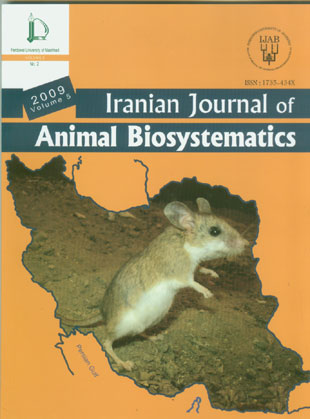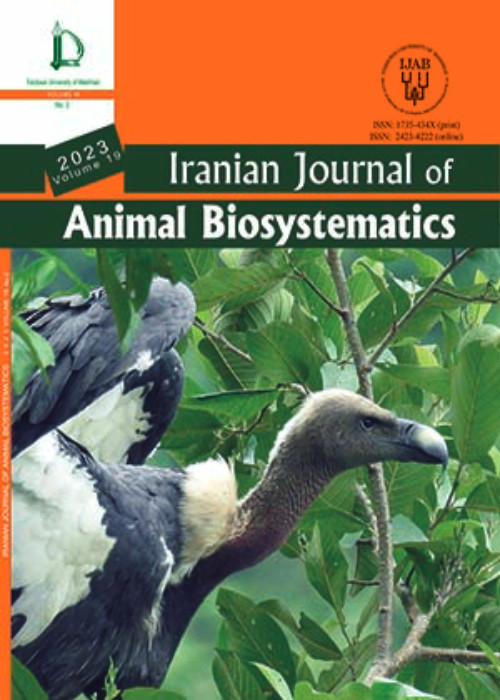فهرست مطالب

Iranian journal of animal biosystematics
Volume:5 Issue: 1, Winter-Spring 2009
- 80 صفحه،
- تاریخ انتشار: 1389/10/11
- تعداد عناوین: 7
-
-
Pages 1-8The kutum (Rutilus frisii kutum) is one of the economically valuable species of CaspianSea. Two different races of this fish exist in the Caspian Sea, the spring race and theautumn race. The aims of this study were to analysis the population genetic structure andgenetic diversity among and between populations of these races based on microsatellitemarkers. For this purpose, 100 samples of adult kutum from two regions of Caspian Sea(Anzali Wetland and Shiroud River) were collected. DNA was extracted and 31 pairmicrosatellite primers were used for PCR and 10 made polymorphic patterns. In thisstudy 191 alleles were observed totally. The maximum numbers of alleles (18) were foundin two loci (Ca1 and Ca3) and the minimum number of alleles (2) was found in MFW1locus. The differences between both races were not statistically significant (P>0.05),neither for average number of alleles per locus nor for observed heterozygosities. Thecalculated Fst and Rst between two races was 0.056 and 0.15 which shows that thegenetic difference was significant (P< 0.01). Spring race in MFW1 locus and autumn racein Lid1 locus were at Hardy-Weinberg equation but not in other loci in both races. Thegenetic distance was 0.407 which indicating the greatest genetic distance between the two studied races. The data generated in this study showed that the spring and autumn races of kutum in two region of southern part of Caspian Sea are two independent populations.
-
Pages 9-15The Persian Brook Salamander, Batrachuperus persicus, an endemic amphibian species, isfound in north and northwest of Iran (south and west of the Caspian Sea in Mazandaranand Ardabil Provinces). It has a limited range and its current situation is unknown. So, asurvey was conducted from Oct. 2006 to Nov. 2007 to know more about conservationstatus, habitat future and threats based on field works in two most known habitats,Weyser, southeast of Chalus in Mazandaran province and Delmadeh village, southeast ofKhalkhal in Ardabil province. In four times of visiting, the senior author just found fourliving salamanders. The result showed that most wild populations are threatened andeven going into extinction. Habitat loss, severe droughts, deforestation and of people''slack of knowledege are among the most important threats. It is evident that this species is vulnerable and deserves strict protection at national and international levels. It is clearthat for a virtual conservation plan, we need to support the streams and habitats of thisspecies in long time.
-
Pages 17-24In this study a total of 29 Eremias strauchi strauchi specimens (10 males, 16 females andthree juveniles), collected from different localities in northwest of Iran were examined.The study was based on morphological features including color pattern, morphometricmeasurements, pholidotic characters, as well as ecological and biological observationsespecially habitat, reproductive biology and distribution. Habitat features and newdistribution localities were documented. Egg characters of Eremias strauchi strauchi such as shape, size, number and color are reported for the first time. Also, some other newinformation on this species has been given.
-
Pages 25-32As a model for study of spermatogenesis durability in lizards, 75 specimens of the snakeeyed lizard, Ophisops elegans, were collected from western Iranian Plateau. The testes of each specimen were removed, during four years from March to October. Based on histological and statistical analyses, three phases were observed in Ophisops elegans asfollows: (I) active phase that occurs from March to May, (II) transitional phase thatoccurs from June to July and finally (III) resting phase that occurs from August toOctober. Based on this study, spermatogenesis durability in O. elegans is less than fivemonths. Spermatogenesis durability of O. elegans occurred in post-hibernation period andstopped in pre-hibernation.
-
Pages 33-46The rapid fringe-toed lizard, Eremias velox, is widely distributed in the Iranian plateau andCentral Asia. Several local morphotypes have so far been reported from different parts ofits range, representing this taxon as a species complex. In an attempt to revealphylogenetic relationships among various populations of this complex group, 37specimens from 13 geographically distant localities in Iran and central Asia, coveringmost parts of its range, were sampled. Using Inter Simple Sequence Repeat amplification(ISSR-PCR) as a molecular marker, whole the nuclear genome of all specimens wasscreened. Phylogenetic analysis of the prepared data set successfully recovered sevenmajor clades within the E. velox complex. Relationships among the major clades werehighly resolved with remarkable statistical supports and well correspond to thegeographic distribution of the populations. The reconstructed phylogeny implies that theclade as a whole has been originated in the Iranian plateau and expanded into central Asiabefore uplifting the Kopet-Dagh Mountains. It has then undergone a rapid cladogenesisin the latter area and produced several morphotypes. Within the Iranian clades two maingroups could be defined, the foothill and highland dwellers and the open plane and desertdweller populations. The phylogenetic tree together with the estimated amounts ofgenetic distances among the independent lineages, provide good grounds for afundamental revision of the taxonomic status of the Eremias velox complex.
-
Pages 47-58
Apodemus witherbyi is a species with wide distribution and geographic variation in theIranian plateau. This species exists in syntopic, sympatric or parapatric with other fourreported Sylvaemus species from Iran, i.e. A. hyrcanicus, A. uralensis, A. flavicolis and A.avicennicus. In this study 33 specimens from different localities in NW Iran were examinedto study the taxonomic status and the intra-specific variation of the populations. Thestudy was carried out based on the RFLP analysis of cytochrome b (mtDNA), as well asthe morphological and morphometric analyses external, cranial and dental characters. Theresults reveal that all the specimens studied belong to a same species, A. witherbyi.Variation range of the morphometric characters and the frequency of the morphologicaltraits are provided.
-
Pages 59-77In order to determine the interspecific differences, morphometric characters ofexternal, skull and tooth row variables- of different populations of fourteenspecies of Jird: Meriones persicus; M. rex; M. hurrianae; M. tristrami; M. tamariscinus;M. vinogradovi; M. meridianus; M. unguiculatus; M.crassus; M. shawi; M. sacramenti; M.libycus. M. zarudnyi and M. grandis were investigated in a wide range from NorthAfrica to Central Asia. The material came from Iran, Saudi Arabia, Syria, Israel,Morocco, Jordan, Russia, Mongolia, and Turkmenistan.Univariate and multivariate analyses were performed, euclidian distance betweensamples was computed and the corresponding distance matrix was used torepresent a dendrogram and unrooted tree using the Minimum Spanning Treealgorithm.The length of hind foot, ear, mandible and auditory bulla are highly important inmaking distinction between the species. The ratio of tympanic bulla length to thelength of skull shows the presence of two adaptive groups: One with relativelysmall tympanic bulla which include M. persicus, M. tristrami, M. vinogradovi, M. shawi,M. grandis, M. zarudnyi, M. rex, M. sacramenti and M. hurrianae and the other withrelatively large bulla which include M. crassus, M. libycus, M. tamariscinus, M.meridianus and M. unguiculatus. The Minimum Spanning Tree method showed thatall species of Jird could be regrouped into two branches: one with small, and theother with medium and large overall size. This difference may reflect geographicand adaptive statue of different species of Jirds.


